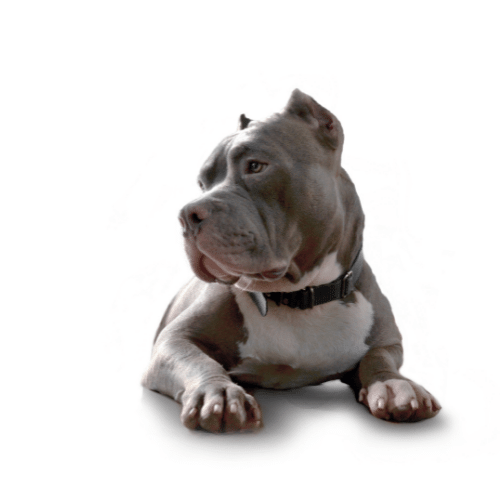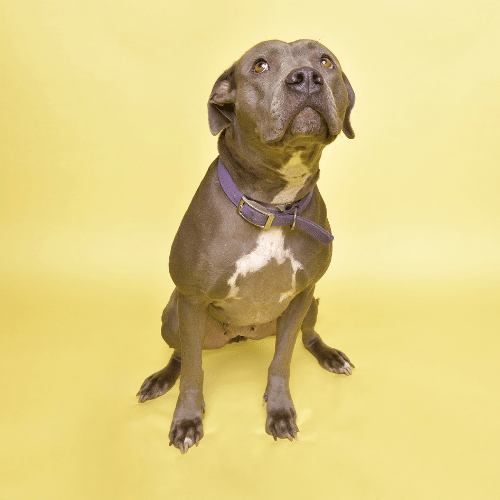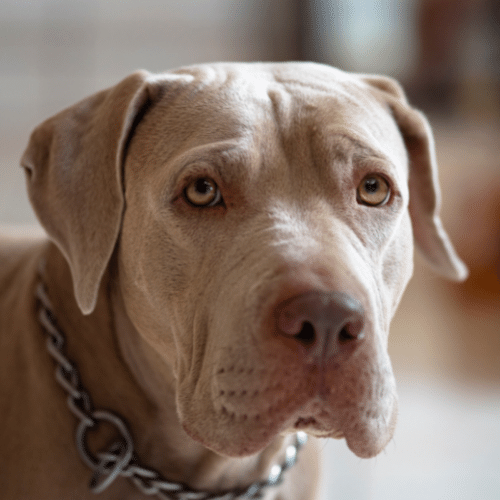Blue Fawn Pitbull
July 10, 2021 2021-08-15 17:46The American Pit Bull Terrier is a medium-sized breed with an extremely short, smooth coat. This comes in a variety of different colors. In fact, the UKC accepts them in any color but merle. The Blue Fawn Pitbull occurs when the dog inherits two dilute genes. Because this gene is recessive, one must be inherited from both parents to produce this coloration (you may know this color from other breeds, such as the Weimaraner).
This does make them a bit rarer than other color types, so they may cost a bit more than others. Besides the color, these dogs are the same as all other American Pit Bull Terriers.
Table of Contents

Appearance
Pitbulls that come in this color are rarer because they must inherit two very specific genes from their parents. This makes the black in their coat diluted, which gives them their blue-fawn coloration. This gene is recessive, and it is somewhat rare to find a puppy that happens to inherit these two genes from their parents.
Besides their special coat coloration, these dogs are very similar to others of their breed. They usually fall easily into the medium-sized category. You can expect a male to weigh between 35- to 60-pounds, while females are around 30- to 65-pounds. Males are usually a bit larger than females, as you can see. However, the size difference isn’t as dramatic as it is for other breeds.
The American Pit Bull Terrier has a smooth and short coat. Their eyes are either round or almond-shaped, while their ears can range from medium to large.
As we’ve discussed, pitbulls can come in a wide range of colors. Red, black, and buckskin are the most common. Blue fawn occurs less often, as it is the result of very specific genetics. Most breeders who have Blue Fawn Pitbulls specialize in producing this coloration. Pitbulls can have a variety of different patterns, including the Blue Fawn Pitbull. Many have white markings of some sort, though other colors are also possible.

History
The Blue Fawn Pitbull’s history starts hundreds of years ago. Originally, Pitbulls were a mixed breed that resulted from crossing the Old English Terriers with the Old English Bulldogs. Eventually, these two breeds went extinct, leaving just the Pitbull.
These dogs were used in the United Kingdom for bloodsports, like bear baiting and bull baiting. These sports were eliminated in 1835 as the country introduced animal welfare laws. However, the dogs were still used in underground and barely legal versions of the sport for decades longer. They were also utilized for dogfighting, which was easier to conceal and plan than bull baits.
These Pitbulls were exported to the United States in the late nineteenth century. They were still used for dogfighting and similar sports once inside the US. However, they were also well-known as companion animals. Many were used on farms and out west to hunt feral cows and hogs, which were often too dangerous for other dog breeds. Eventually, dogfighting was outlawed in 1976 in all states.
The United Kennel Club was the first organization to recognize this breed. They recognized them as the American Pit Bull Terrier. However, in 1936, the American Kennel Club recognized them as the American Staffordshire Terrier. They were attempting to distance the dog from it’s bloody past. However, the “pitbull” nickname still stuck, though the name change did cause some confusion about what this moniker actually meant.
Personality and temperament
These dogs are extremely friendly and outgoing. They often act like they are much smaller than they are. Their personality is very similar to other terrier breeds. Many describe them as having a “zest for life.” While these dogs are a very happy breed, it is important to understand that they can be a bit hyperactive. It isn’t odd for them to get very excited. They may act similarly to a small dog in this way – except they can weigh as much as 65 pounds.
The UKC describes these dogs as “eager to please and brimming over with enthusiasm.” We can absolutely agree with that.
The Blue Fawn Pitbull is known for being very good with children. They are very patient and often a lot like children themselves. Their high level of confidence and larger size makes it unlikely that they will be scared of children. Therefore, fear-based aggression is rare. They will often put up with a lot of children.

Despite some misconceptions, these dogs are not good guard dogs in the least. They may be a good alert dog, as they are constantly aware and tend to be a bit noisy. However, they will often bark at strangers in excitement, not aggression. They absolutely love attention for everyone, including family members and strangers.
Aggression is extremely undesirable in the breed and is bred out by all professional breeders. In fact, human aggression is considered a disqualification factor for show Pitbulls. Despite this, there is a lot of misconceptions surrounding this breed.
Many people mistakenly think that these dogs are more dangerous than other breeds. This has even led to anti-breed laws controlling who can own these canines. Some even ban them outright. However, there isn’t actually any evidence that these dogs are any more aggressive than any others. Much of the confusion likely comes with people’s tendency to mislabel other breeds like Pitbulls, especially when aggression is involved. This leads to bites being labelled as pitbull bites, though they are actually caused by other breeds.
Studies have found that there is no correlation between a dog’s aggression level and their breed. Instead, socialization and training play a much larger role. If a dog is introduced to many different people and dogs from a young age, their odds of being aggressive are lower.
With that said, some Pitbulls do have higher rates of dog-dog aggression, especially within the same gender. However, studies have found that most of them “possess excellent social skills.” Again, socialization is going to be the biggest factor here.

Training and exercise needs of a Blue Fawn Pitbull
When it comes to training, most of your focus should be on socialization. While it isn’t fair, Pitbulls are more likely to be considered aggressive than other breeds. Therefore, it is extra-important that your dog is well-socialized, which will prevent them from showing fear-based aggression when introduced to new situations.
Socialization is pretty easy to accomplish with this breed, though. Their natural confidence and outgoing nature mean that they usually approach new situations with optimism. Your job is simply to ensure that they are introduced to many different people and situations at a young age. This will prevent them from being scared when they are older, which limits the chance for aggression.
These dogs have strong jaws and love to chew. Many owners struggle with destructiveness and have to crate their Pitbulls when they are unsupervised, in addition to provide plenty of appropriate chew items.
Puppy classes are a great option for this breed, as they provide a suitable opportunity for socialization in a safe space. However, you shouldn’t rely on these puppy classes only. Be sure that you also introduce your dog to other situations as well.
Because this breed has strong prey drive, you should be very careful with Pitbulls around smaller pets. They should especially never be allowed to fight or chase cats or other dogs.
These dogs are quite easy to train due to their higher intelligence and people-pleasing natures. They are not particularly stubborn when it comes to training and following commands. However, they are extremely distractable, especially when new people are involved. It is common for them to have “selective hearing” in these situations.
They cannot be trusted off-leash for this reason. Their recall command is never going to be very reliable, which can get them into trouble. Make sure to always keep your Pitbull on a collar (or harness) and leash.
Health and care
Common health issues
Pitbulls are pretty healthy. Like all breeds, they are prone to a few different health problems, though. Many pitbulls have hip dysplasia, which is a condition that affects the use of the hips. This problem is characterized by the dog’s hip socket not fitting together properly. This causes the ball and socket to rub against each other, causing extra wear.
Usually, hip dysplasia affects larger dogs. However, even though Pitbulls fit in the medium-sized category, they seem to be much more affected by it than most breeds.
Similarly to hip dysplasia, they are also affected by kneecap problems. Usually, the kneecap sits in a small grove on the front of the femur. However, in some dogs, this groove is not shaped properly to hold the kneecap in place. Sometimes, it can slide out from its usual place and damage the surrounding tissue.

This can be caused by injury and environmental issues. However, genetics can also play a role. Sometimes, an injury pushes the kneecap out of place. Other times, the groove can simply not fit the kneecap, to begin with.
Degenerative myelopathy affects a large percentage of Pitbulls. According to some records, upwards of 18% of Pitbulls are directly affected by this disease. However, this only includes dogs that show symptoms. Because this is a recessive trait, many dogs carry a single gene and never show symptoms. Therefore, the rate of carriers is probably very high.
Simply put, this condition causes the spinal column to slowly degenerate over the dog’s lifespan. This causes progressing weakness in the dog’s back legs. Usually, it starts with muscle weakness that is often easily mistaken for hip dysplasia or a similar disease. However, paralysis slowly occurs. While the legs are just affected at first, the bladder and urinary tract are eventually affected as well.
There is no cure for this disease. Typically, vets use supportive therapy like exercise to slow the progression of this disease. However, all dogs will eventually become paralyzed, needing a cart to help them get around.
Congenital heart defects are somewhat common in Pitbulls as well. These are heart malformations that occur when the fetus is developing, so they are with the dog when they are born. Many are benign and don’t cause any problem. Some are extremely serious when the puppy is born, usually leading to their death at a young age. Others are unnoticeable until later when their weakening heart begins to fail.
Many of these conditions are genetic. Therefore, it is important for breeding dogs to be tested before they produce puppies. A genetic heart defect can easily hide until a breeding dog is older and has already passed the gene onto dozens of puppies. This is one reason why purchasing from a breeder is so important. They usually test their dog before breeding.
All Pitbulls are prone to Demodex Mange, including those with the Blue Fawn coloration. In most dogs, this disease is minor. It causes the dog to lose fur in small areas where the infection is occurring. This is referred to as a “localized” infection. Usually, some medication from the vet quickly clears up this condition.
However, some Pitbulls carry a trait that compromises their immune system in response to this mange. They simply don’t fight it off like other dogs. Their whole body will be affected, causing them to lose fur everywhere. Their skin will often bleed without treatment, causing them to scab over before bleeding again. This is referred to as a “generalized” infection.
These dogs are a bit more complicated to treat. Ivermectin injections are often provided, but other medications may be needed as well. It isn’t that this disease is deadly. It is just harder to treat because the dog’s immune system isn’t helping.
Pitbulls are well-known for having an immunodeficiency towards parvovirus as well. They are more likely to get it and develop serious symptoms quickly. Luckily, there is a vaccination for this condition. It is important that you vaccinate your Blue Fawn Pitbull correctly to prevent this disease.
Grooming
Pitbulls do not require much grooming. In this circumstance, they are quite low-maintenance. Their coat is short and smooth, so you don’t have to worry about matting or anything of that sort.
Still, we do recommend a weekly brushing routine, as Pitbulls do shed quite profusely. While the Blue Fawn Pitbull’s fur won’t be as dark and noticeable as other colors, it can easily coat your home if left unattended. A slicker brush can help remove the excess fur with some ease. These grooming sessions will also remove other dirt and debris from the dog’s coat, elongating the time you can go between baths. It also helps spread the natural oils in their fur, keeping their coat shiny and healthy.
Pitbulls don’t need baths extremely often. However, you should plan on bathing them around every two months. More than this can dry out their coat, so we typically don’t recommend it. A dry coat will get dirtier faster and cause skin irritation. Luckily, the blue fawn color usually doesn’t get very dingy looking quickly.
Like all dogs, you should keep their teeth fairly clean using dog-safe toothpaste. Dental chews and simply giving your dog dry food are not reliable ways of keeping your dog’s teeth clean. For this reason, they simply must use toothpaste and a toothbrush. Use them 3-4 times a week.
You should trim your dog’s nails as well, ensuring that they don’t get too long. Long nails are hard to walk on and can cause splits, which can be extremely painful and a common source of infections.
While these dogs aren’t prone to ear infections, it is still important to keep an eye on their ears. Infections are usually caused when dirt and debris get in the ear and stay there. Cleaning can go far to prevent this. Clean out your dog’s ears with a wet cotton ball anytime you notice that they’re getting dirty.

Adopting a Blue Fawn Pitbull
Pitbulls are a very common breed in the United States. In fact, they were once considered to be the American breed and were used on wartime posters throughout the two World Wars. While they are generally less popular today than they were then, it is very easy to find them as shelters and animal rescues.
There are many breed-specific rescues out there. These often have many dogs at a time, making them a good place to look when you’re set on a particular color like blue fawn. Your local animal shelter is a good option as well.
Adopting your dog from a rescue is typically the cheapest option. Most shelters only charge $100 to $400 for each dog. Puppies are usually more expensive since they require more vet care while at the rescue. Pitbulls often have a bad reputation, so many of them sit in the shelter for longer than other dogs. Some rescues provide a discount on these dogs for this reason.
You can also find Pitbulls at many breeders. Due to their popularity, it isn’t very odd to find breeders that specialize in this breed. Many specialize in particular colorations, so this may be your best option if you’re looking for a Blue Fawn Pitbull specifically. This is a rarer coloration, so it may be difficult to find at a rescue.
Furthermore, breeders provide the proper health testing for their dogs that prevents certain genetic conditions from being passed on. This isn’t necessarily the case for dogs bred by people who aren’t breeders. This can lower the amount you spend on vet bills over the long run.
However, breeders are often more expensive than rescues. This is largely because of all the extra money they put into their dogs.
Experience level for owning a Blue Fawn Pitbull
These dogs are often best for those who have previously owned a dog, simply due to their energetic nature. If left to their own devices, they can get bored and exhibit destructive behaviors. Therefore, they require a bit more focused care than other breeds.
Of course, if you’re in an active family, this dog’s activity levels can be easy to meet. While they do tend to act quite energetic, their endurance is actually quite low. Therefore, they only need a few walks before they are worn out and tired. A family with a few energetic children or adults that like to go for jogs in the morning can typically wear these dogs out quickly.
These dogs are quite easy to train, but it does help if you’ve had some experience training dogs before. Their distractibility can be a bit unnerving unless you know what you’re dealing with. It is important to know these dogs’ limits, which can be difficult if you’ve never owned a dog before.
The bottom line
While they have a bad reputation, Blue Fawn Pitbulls make wonderful family dogs. They are outgoing and friendly. Many are great with children due to their patient nature and confidence. They aren’t easily scared and usually get along with just about everyone. There is a reason they are referred to as “nanny dogs.”
These dogs do need some socialization and are quite energetic. However, their ease of training and low endurance often makes them easy to care for despite these traits. If you’re looking for an all-around family dog, these will often fit the bill.
The blue fawn coloration can be quite rare, as it requires two recessive genes. Finding a breeder that specializes in these colorations is often straightforward, though.

Author: Kristin
Kristin was born in Tennessee and currently lives there with her husband and children. She is passionate about educating pet parents and helping them make the best possible decisions for their pets. She currently owns one dog, two cats, a lizard, and a variety of fish.

